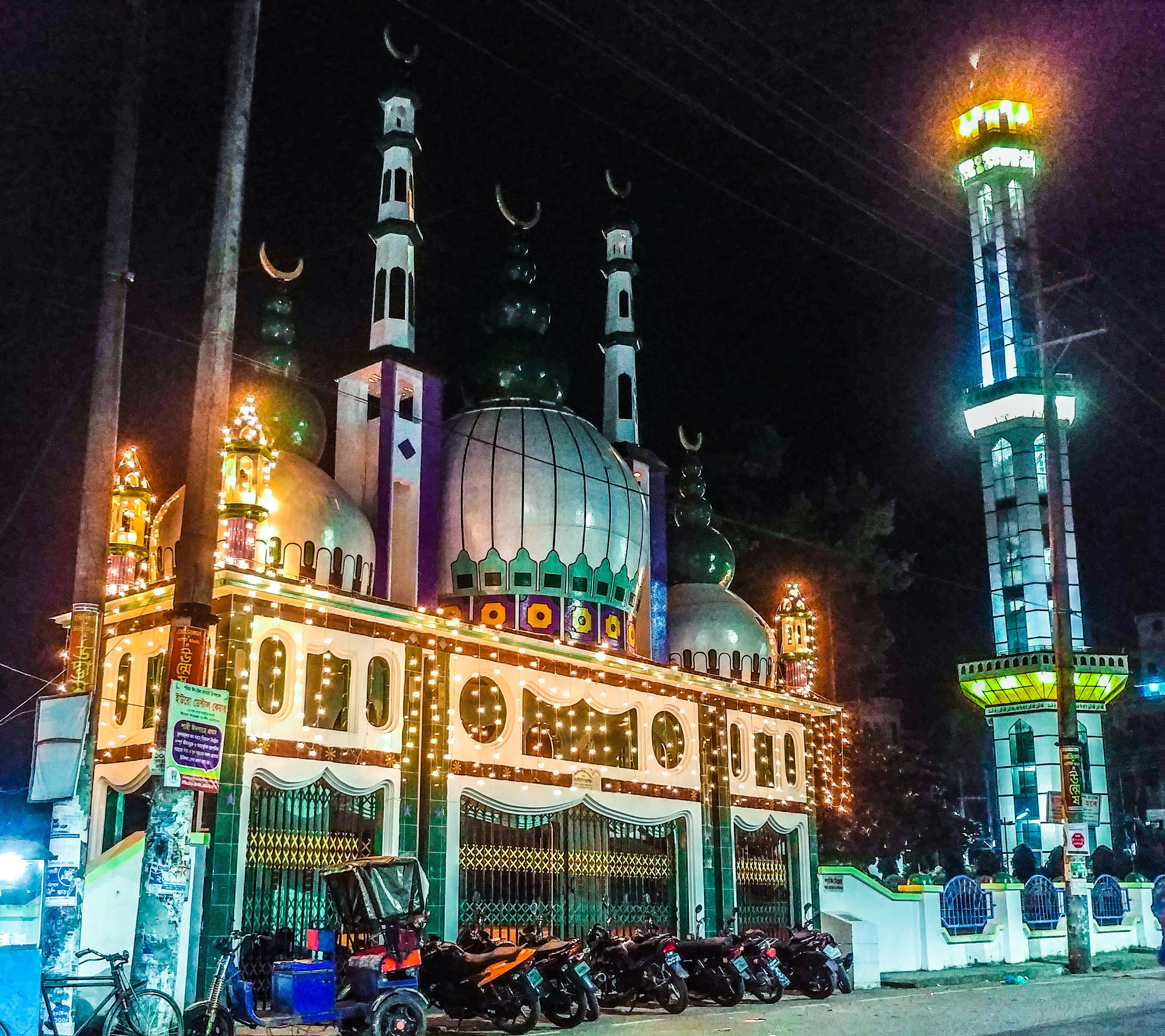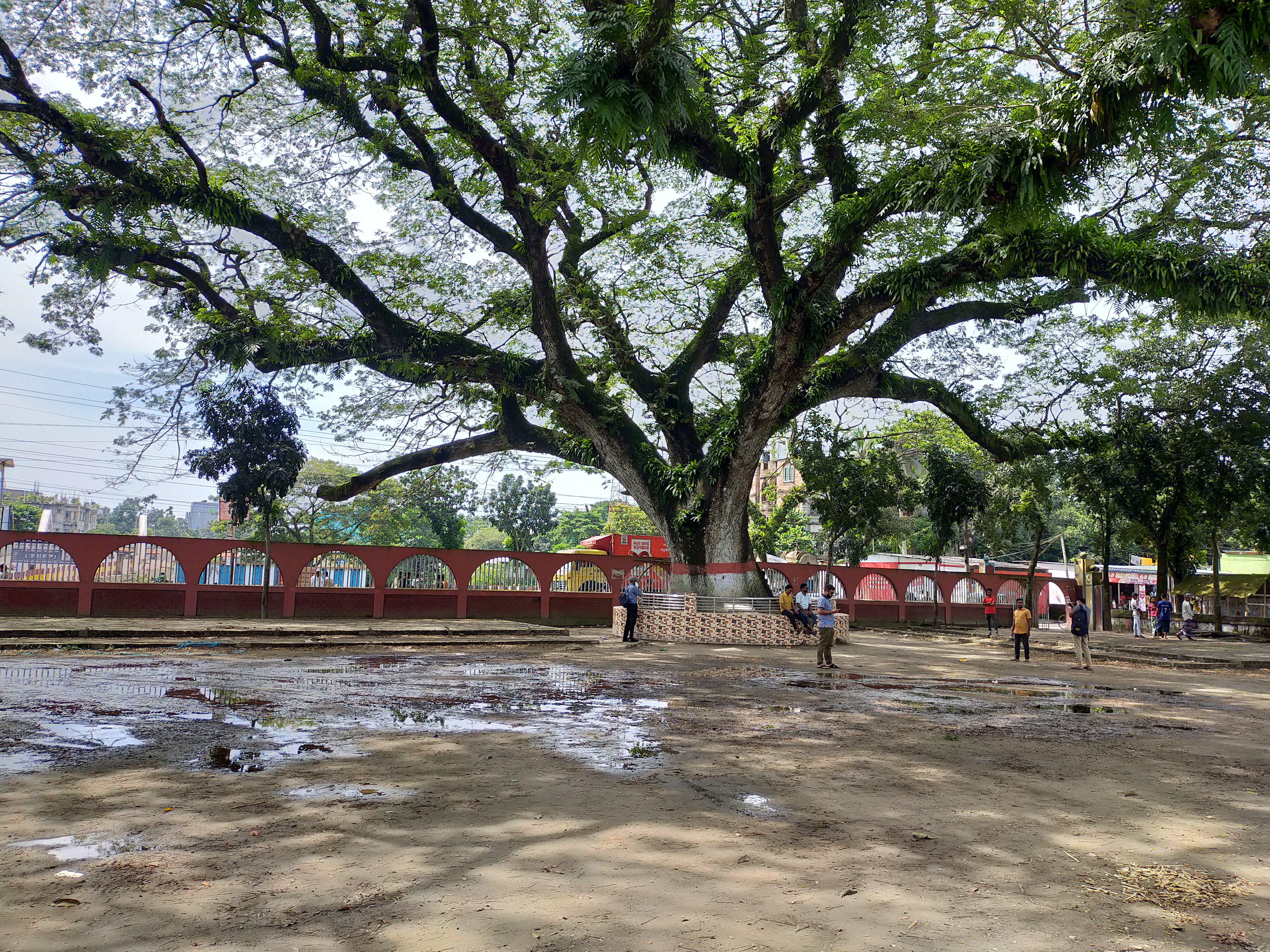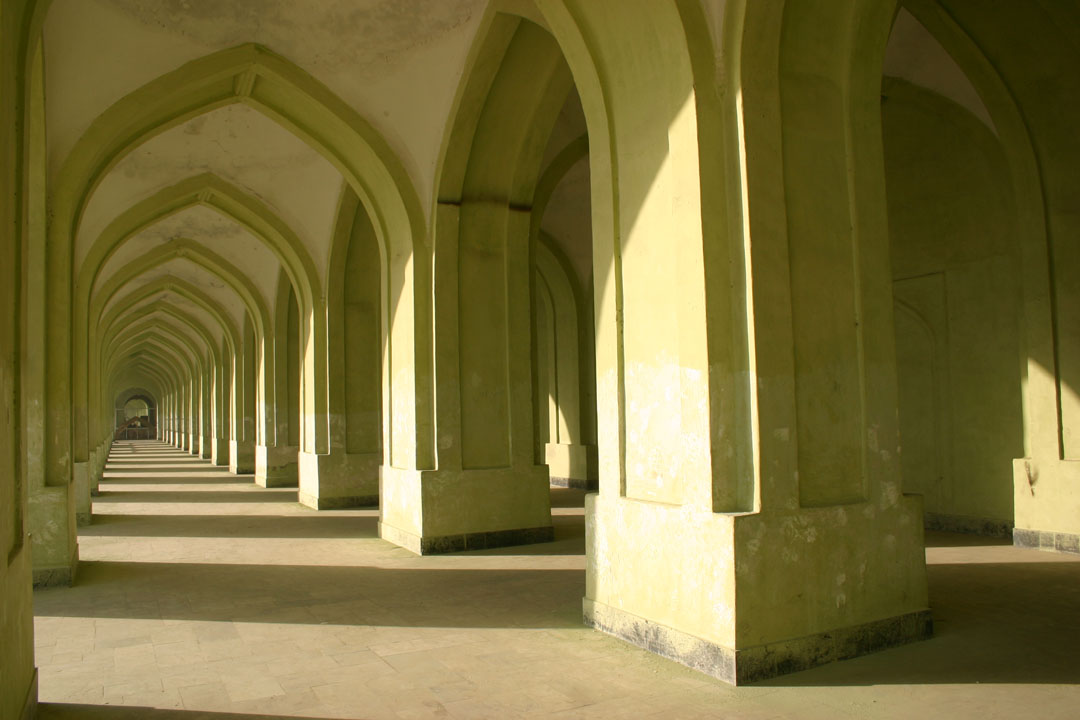|
Eidgah
Eidgah or Idgah, also Eid Gah or Id Gah ( fa, "site of Eid bservances; bn, ঈদগাহ; pnb, ; ur, ; hi, ईदगाह) is a term used in South Asian Islamic culture for the open-air enclosure usually outside the city (or at the outskirts) reserved for Eid prayers offered in the morning of Eid al-Fitr and Eid al-Adha. It is usually a public place that is not used for prayers at other times of the year. On the day of Eid, the first thing Muslims do in the morning is gather usually at a large open ground and offer special prayers, in accordance with the Sunnah (traditions of Muhammad). Although the usage of the term ''Eidgah'' is of Indian origin, it may be used for the ''musalla'', the open space outside a mosque, or other open grounds where Eid prayers are performed, due to the lack of a specific Islamic term for a site of Eid observance. The Eidgah is mentioned in the famous Bengali poem by Kazi Nazrul Islam, O Mon Romzaner Oi Rozar Sheshe. Prescriptions i ... [...More Info...] [...Related Items...] OR: [Wikipedia] [Google] [Baidu] |
Eidgah Mosque
Eidgah or Idgah, also Eid Gah or Id Gah ( fa, "site of Eid bservances; bn, ঈদগাহ; pnb, ; ur, ; hi, ईदगाह) is a term used in South Asian Islamic culture for the open-air enclosure usually outside the city (or at the outskirts) reserved for Eid prayers offered in the morning of Eid al-Fitr and Eid al-Adha. It is usually a public place that is not used for prayers at other times of the year. On the day of Eid, the first thing Muslims do in the morning is gather usually at a large open ground and offer special prayers, in accordance with the Sunnah (traditions of Muhammad). Although the usage of the term ''Eidgah'' is of Indian origin, it may be used for the ''musalla'', the open space outside a mosque, or other open grounds where Eid prayers are performed, due to the lack of a specific Islamic term for a site of Eid observance. The Eidgah is mentioned in the famous Bengali poem by Kazi Nazrul Islam, O Mon Romzaner Oi Rozar Sheshe. Prescriptions i ... [...More Info...] [...Related Items...] OR: [Wikipedia] [Google] [Baidu] |
Dhanmondi Shahi Eidgah
The Dhanmondi Shahi Eidgah ( bn, ধানমণ্ডী শাহী ঈদগাহ), also known as Mughal Eidgah ( bn, মোগল ঈদগাহ), is located in Saat Masjid road, in Dhanmondi residential area of Dhaka, Bangladesh. The Eidgah was built in 1640 CE during the Mughal era and has been in use for Eid celebration since then. The structure is a listed archaeological site of the Department of Archaeology and has historical, architectural and heritage values. It is an example of Mughal architecture. Conservationist architect Abu Sayeed M Ahmed wrote, "This Eidgah is the oldest surviving Mughal monument in Dhaka city. There is no second one with the architectural forms and features similar to it." History The Mughal Eidgah is a monumental structure built during the Mughal Empire. the Eidgah was built by Mir Abul Qasim, a Diwan of Shah Shuja and builder of Boro Katra. The Mughal subahdars and diwans living in this land used to come to the Eidgah for Eid prayers ... [...More Info...] [...Related Items...] OR: [Wikipedia] [Google] [Baidu] |
Sholakia Eidgah Maidan
Sholakia ( bn, শোলাকিয়া) is a locality near Kishoreganj town in Bangladesh. It is famous for its Eidgah where the largest congregation of Eid prayer in Bangladesh is held on the occasion of '' Eid ul-Fitr'', the day of celebration after the Ramadan, the month of fasting. 400,000 people join the prayer on every Eid. The Eidgah, on the bank of river Narosunda is reported to be in size, accommodating 250 rows or about 150,000 of participants for every congregation. An equal number of participants take part in the prayer using the fields, roads and courtyards around the Eidgah. A small number of elites make use of the two-storied mimbar (prayer hall with towers for ''adhan'') nearby, which can accommodate about 500 people. The prayer on the occasion of '' Eid ul-Adha'', the festival of ''qurbani'' or sacrifice, is also comparably large. The regular population of Sholakia is 1,026, consisting 180 households. Organization Mufti Moulana Farid Uddin Masud has be ... [...More Info...] [...Related Items...] OR: [Wikipedia] [Google] [Baidu] |
Eidgah, Kheri
Eidgah or Kheri Eidgah is a mosque and Eidgah near the railway tracks between Lakhimpur and Kheri. Construction The foundation of the historic Eidgah was laid in North West of Kheri Town, outside the dwelling area. Architecture The courtyard of the mosque can be reached from entrances on three sides. On the day of Eid, the area outside mosque is used for food stalls, shops and by street entertainers. See also *Eidgah Eidgah or Idgah, also Eid Gah or Id Gah ( fa, "site of Eid bservances; bn, ঈদগাহ; pnb, ; ur, ; hi, ईदगाह) is a term used in South Asian Islamic culture for the open-air enclosure usually outside the city (or at th ... * Islamic architecture Notes External links Flickr: Photos tagged wit"Eidgah Kheri"{{Mosques in India Mosques in Uttar Pradesh Tourist attractions in Lakhimpur Kheri district Eidgahs ... [...More Info...] [...Related Items...] OR: [Wikipedia] [Google] [Baidu] |
Sylhet Shahi Eidgah
Sylhet Shahi Eidgah ( bn, সিলেট শাহী ঈদগাহ), or simply Shahi Eidgah, is an open prayer hall situated in Sylhet, north-east Bangladesh, three kilometers to the north-east of the circuit house, meant for the Eid prayers. It was built during the rule of Mughal Sultan Sarfaraz Khan. More than 100,000 people can perform prayer at same time in this eidgah. It is also one of the most visited tourist spots in the city. Recently, the gates were rebuilt to ensure safety and security. As well as for prayer uses and Islamic congregations, the eidgah has historically been a place to give speeches and host rallies by the likes of Mohandas Gandhi and Muhammad Ali Jinnah. There have also been battles taken place there such as the Muharram Rebellion. History During the rule of Mughal emperor Aurangzeb, Farhad Khan was appointed as the faujdar of Sylhet. Farhad Khan supervised the construction of the Shahi Eidgah on a hill in the 17th century. On 16 December 1782 ... [...More Info...] [...Related Items...] OR: [Wikipedia] [Google] [Baidu] |
Id Gah Mosque
Eid Gah Mosque or Id Gah Mosque ( prs, مسجد عیدگاه), is the second largest mosque in Kabul, the capital of Afghanistan. It is considered the cardinal religious mosque in the country, where a million people offer Eid prayers twice a year. It is located near the Mahmud Khan bridge and National Stadium in the eastern part of the city, in the Shar-e-barq of Kabul, which is one of the wealthier areas of the city. The "Id Gah" or "Eid Gah" refers to an open space where people congregate during national and religious celebrations. The open grounds of Id Gah are also used as a parking lot for trucks that transport goods to and from Peshawar. In most references Babur, a Muslim warrior at the time had just invaded India and ordered a Mosque be built to glorify Islam, he had his warriors bring back precious stone from the Punjab, Sindh and surrounding areas and had Persian architects build a structure for his Kabul subjects. It has been the scene of religious festivals, re ... [...More Info...] [...Related Items...] OR: [Wikipedia] [Google] [Baidu] |
Eid Al-Fitr
, nickname = Festival of Breaking the Fast, Lesser Eid, Sweet Eid, Sugar Feast , observedby = Muslims , type = Islamic , longtype = Islamic , significance = Commemoration to mark the end of fasting in Ramadan , date = 1 Shawwal , date2019 = 4 June (Saudi Arabia and some other countries) 5 June (Pakistan and some other countries) , date2023 = 21 – 22 April , date2024 = 10 – 11 April , celebrations = Eid prayers, charity, social gatherings, festive meals, gift-giving, dressing up, Lebaran , relatedto = Ramadan, Eid al-Adha Eid al-Fitr (; ar, عيد الفطر, Eid al-Fiṭr, Holiday of Breaking the Fast, ) is the earlier of the two official holidays celebrated within Islam (the other being Eid al-Adha). The religious holiday is celebrated by Muslims worldwide because it marks the end of the month-long dawn-to-sunset fasting of Ramadan. It falls on the first day of Shawwal in the Islamic calendar; this doe ... [...More Info...] [...Related Items...] OR: [Wikipedia] [Google] [Baidu] |
Mosque
A mosque (; from ar, مَسْجِد, masjid, ; literally "place of ritual prostration"), also called masjid, is a place of prayer for Muslims. Mosques are usually covered buildings, but can be any place where prayers ( sujud) are performed, including outdoor courtyards. The first mosques were simple places of prayer for Muslims, and may have been open spaces rather than buildings. In the first stage of Islamic architecture, 650-750 CE, early mosques comprised open and closed covered spaces enclosed by walls, often with minarets from which calls to prayer were issued. Mosque buildings typically contain an ornamental niche ('' mihrab'') set into the wall that indicates the direction of Mecca ('' qiblah''), ablution facilities. The pulpit ('' minbar''), from which the Friday ( jumu'ah) sermon (''khutba'') is delivered, was in earlier times characteristic of the central city mosque, but has since become common in smaller mosques. Mosques typically have segregated spaces for m ... [...More Info...] [...Related Items...] OR: [Wikipedia] [Google] [Baidu] |
Eid Prayers
Eid prayers, also referred to as Salat al-Eid ( ar, صلاة العيد), are holy holiday prayers in the Islamic tradition. The literal translation of the word "Eid" in Arabic is "festival" or "feast" and is a time when Muslims congregate with family and the larger Muslim community to celebrate. There are generally two central Eids that take place in accordance with the Islamic lunar calendar (hence the additional name Șālat al-’Īdayn ( ar, صلاة العيدين "Prayer of the Two Eids"): * Eid al-Fitr ( ar, عيد الفطر, links=no), also known as the "Smaller Eid" is a celebration marking the end Ramadan, the Islamic holy month of fasting, welcoming the new month of Shawwal and lasts for a period of three days. Mandatory charity, or Zakat, specifically Zakat al-Fitr (Zakat of Eid Al-Fitr) is offered to the poor by every financially-able Muslim (preferably prior to the offering of the prayer) to ensure that those who are less fortunate may also participate in the ... [...More Info...] [...Related Items...] OR: [Wikipedia] [Google] [Baidu] |
O Mon Romzaner Oi Rozar Sheshe
O Môn Rômzaner Oi Rozar Sheshe Elo Khushir Eid ( bn, ও মন রমজানের ঐ রোজার শেষে এলো খুশির ঈদ) is the most notable Bengali Eid-ul-Fitr song, written by Kazi Nazrul Islam, the national poet of Bangladesh. It is a very common tune heard in Bengali Muslim households around the world. The song was written and composed at the request of Nazrul's disciple, Abbasuddin Ahmed in 1931. It has been covered by many artists around the world. The song is written on the end of the period of fasting and the Islamic holiday of Eid-ul-Fitr. This was regarded by his contemporaries as a significant achievement, as Bengali Muslims had been strongly averse to devotional music. Bengali lyrics, romanization and English translation Lyrics and romanization: Translation: First recording 4 days after Nazrul wrote the poem, Abbasuddin Ahmed recorded it with his voice. Two months after, it was published on Eid day by The Gramophone Compa ... [...More Info...] [...Related Items...] OR: [Wikipedia] [Google] [Baidu] |
Eid Al-Adha
Eid al-Adha () is the second and the larger of the two main holidays celebrated in Islam (the other being Eid al-Fitr). It honours the willingness of Ibrahim (Abraham) to sacrifice his son Ismail (Ishmael) as an act of obedience to Allah's command. Before Ibrahim could sacrifice his son, however, Allah provided him with a lamb which he was supposed to kill in his son's place because of his willingness to sacrifice his own son in the name of God. In commemoration of this intervention, animals are ritually sacrificed. Part of their meat is consumed by the family which offers the animal, while the rest of the meat is distributed to the poor and the needy. Sweets and gifts are given, and extended family members are typically visited and welcomed. The day is also sometimes called the Greater Eid. In the Islamic lunar calendar, ''Eid al-Adha'' falls on the tenth day of Dhu al-Hijjah and lasts for four days. In the international (Gregorian) calendar, the dates vary from year to year ... [...More Info...] [...Related Items...] OR: [Wikipedia] [Google] [Baidu] |
Id Kah Mosque
The Id Kah Mosque ( ug, ھېيتگاھ مەسچىتى, translit=Hëytgah Meschiti, ; zh, s=艾提尕尔清真寺, t=艾提尕爾清真寺, p=Àitígǎěr Qīngzhēnsì; from Persian: عیدگاه, Eidgāh, meaning "Place of Festivities") is a historic mosque and tourist site located in Kashgar, Xinjiang, China. History The mosque was built by Saqsiz Mirza, the elder of two sons of Amir Sayyid Ali, in 1442 (although it incorporated older structures dating back to 996) to commemorate his ancestors. The mosque covers an area of around 16,000 square meters. The mosque's modern golden-brick structure was built in 1798, replacing the older building, and was further expanded in 1838 to its current size. On 9 August 1933, Chinese Muslim General Ma Zhancang killed and beheaded the Uyghur leader Timur Beg, displaying his head on a spike at Id Kah mosque. In March 1934, it was reported that the Uyghur emir Abdullah Bughra was also beheaded, the head being displayed at Id Kah m ... [...More Info...] [...Related Items...] OR: [Wikipedia] [Google] [Baidu] |





.jpg)
